Long-distance and high key rate Quantum Key Distribution (QKD) research with the Clavis XGR and external single-photon detectors
Clavis XGR with external detectors to enhance your research
Extending the performance of Quantum Key Distribution (QKD) in terms of distance range and key rate is a hot topic. Moreover there are increasing activities related to QKD standardization, security assessment, performance, integration into optical networks and satellite systems, as well as integration into security architectures in combination with other cryptographic primitives.
Working with an industrialized, yet accessible and open QKD system can save time and effort in setting up your lab, and access to raw and intermediate data from the QKD protocol and control over the optical and electronic properties of the QKD system give you flexibility to explore many research directions.
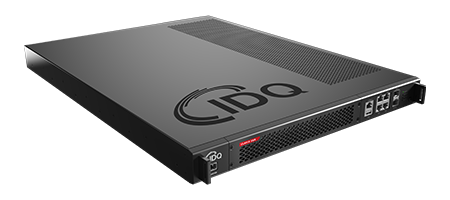
Figure 1 – The XG series is IDQ’s fourth generation of telecommunication-grade QKD, and the XGR model is an extension of our XG series (for production environments). The Clavis XGR, shown above, aims to meet the needs of researchers with features like access to internal data and raw keys, modifiable parameters, and interoperability through standardized interfaces for experimental networks. And it’s an automated, turnkey solution with user-friendly full-stack software.
In a recent webinar, we discussed several possible lab setups involving our Clavis XGR system integrated with external single-photon detectors, from testing QKD from a security point of view, to integrating QKD in optical transport networks. Check it out here.
In this blog post, we’ll discuss one such research direction: using single-photon external detectors to research high-performance QKD on an optical and protocol level.
Experimenting long distance and high key rate QKD research
One important frontier of QKD research is on improving performance, particularly to achieve higher secret key rates at short distances and higher dynamic range. Let’s talk about three levels at which this can be enabled by external detectors.
Level 1 – External SPAD detectors
The use of external SPAD single-photon detectors rather than the integrated detectors typically found in commercial QKD systems can allow access to a larger parameter space for adjusting the detectors. This can enable research into optimization of a particular QKD implementation for different deployment scenarios.
SPAD performance exhibits several tradeoffs that can be interesting to experiment within the context of your setup. First, there is the tradeoff between detection efficiency, dark count rate (DCR), and timing jitter. As the bias current across the diode is increased, detection efficiency and timing jitter improve, but DCR also increases. Second, there is a tradeoff between DCR and afterpulsing probability as a function of the diode temperature; as the temperature is decreased, dark counts are reduced but the afterpulsing probability is increased. IDQ’s detectors employ some tricks to mitigate this (e.g. fast avalanche quenching), but the tradeoff is still present. And finally, there is a tradeoff with the deadtime between afterpulsing probability and maximum detection rate. The ability to adjust these parameters can enable you to find the ideal tradeoffs for your particular implementation and deployment scenario.
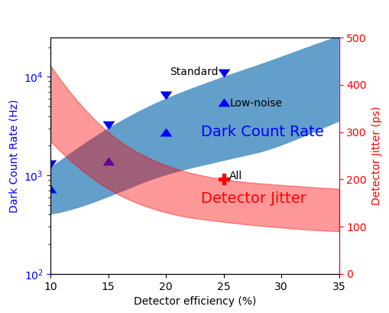
Figure 2 – SPADs exhibit a tradeoff between detection efficiency, dark count rate (DCR), and jitter. As the bias current across the diode is increased, detection efficiency and timing jitter improve, but DCR also increases. For example, typical performance for the ID Qube is 400 cps at 10% efficiency, and 1500 cps at 25% efficiency.
ID Quantique offers several InGaAS SPADs products optimized for telecom wavelengths, all of which are compatible with our Clavis XGR QKD system.
A popular choice is the ID Qube, a compact and cost-effective module that allows easy monitoring and control of several relevant parameters. For example, the detection efficiency can be adjusted between 10% and 35%, and the deadtime of the detector can be adjusted between 100 ns and 80 µs. In both cases this can be done simply via a dropdown menu in the GUI, or script commands if you prefer.
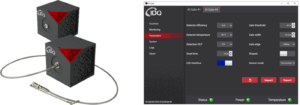
Figure 3 – The ID Qube allows adjustment of the system detection efficiency between 10-35% and deadtime between 100 ns – 80 µs.
If you are interested in better signal to noise performance, the ID230 offers dark count rates (DCR) as low as < 50 cps, unparalleled among commercial SPADs at telecom wavelengths. And the efficiency, deadtime, and temperature of the avalanche photodiode can be adjusted via a simple USB interface.
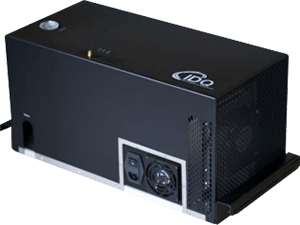
Figure 4 – The ID230 allows adjustment of the system detection efficiency up to 25%, the deadtime from 2 µs to 100 µs, and the temperature of the diode from -50 ˚ C to -90 ˚ C.
Level 2 – Polarization-insensitive SNSPDs
Superconducting nanowire single-photon detectors (SNSPDs) offer the very best in single-photon detection, combining incredibly high detection efficiency, low dark count rates, unparalleled timing precision, and fast recovery times.
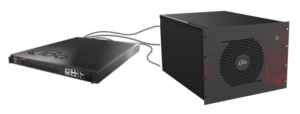
Figure 5 – Combine our Clavis XGR with our ID281 Pro SNSPD system – a compact rack-mountable system designed for reliability, simple integration, and ease of use. One system holds up to 16 detectors..
IDQ has developed polarization insensitive SNSPDs specifically optimized for QKD performance with the Clavis XGR. The performance of these detectors translates into QKD performance, especially faster secret key rates at short distances, and increased dynamic range. See the figure below.
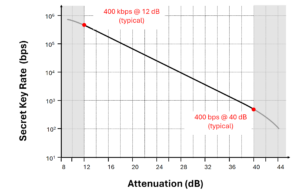
Figure 6 – Unprecedented QKD performance: 400 kb/s secret key rate at 12 dB (typical) and at least 40 dB dynamical range when employing the ID281 as external detectors with the Clavis XGR.
A single ID281 or ID281 Pro system can embed SNSPD detectors to serve up to 5 Clavis XGR receiver modules in parallel. This could allow you to build a star topology with five links over typically 200 km each, for example. The central node in this example, using the ID281 Pro, is only 23U high, including the compressor and vacuum pump (not shown in the figure).
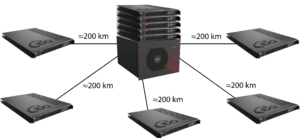
Figure 8 – An ID281 Pro system serving 5 Clavis XGR receiver modules in parallel to implement a star topology. Links over 200 km are feasible with this setup. The central node in this example is 23U high, including the compressor and vacuum pump which are not shown.
Level 3– Standard SNSPDs with polarization control
It is also possible in many cases to control the polarization and benefit from the very best performing SNSPDs available, which are indeed polarization sensitive. This can enable even better performance at long distances, for example 50 dB of range or beyond. Please reach out if you’d like to speak with one of our engineers for advice on how to implement such a setup.
Conclusion
Thanks for your interest in this exciting topic. If you’d like more information, please check out the webinar from which this content was drawn (https://www.idquantique.com/experiment-qkd-in-your-lab/) or reach out to us directly at info@idquantique.com.


